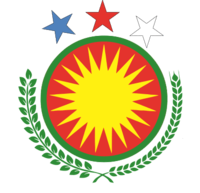Asayish (Rojava cantons)
| Asayish (Asayîş) | |
|---|---|
.jpg) | |
| Active | 2012–present |
| Country | Syria |
| Allegiance | |
| Type | police |
| Role | Security and policing |
| Size | 4,000 (October 2013 claim)[1] |
| Website | http://www.asayish.com/ |
The Asayîş or Asayish (Arabic: الأسايش, Kurdish for security[2]) is the police force of the autonomous cantons within the Federation of Northern Syria – Rojava. Formed in the early stages of the Syrian Civil War, it had initially been established to police areas controlled by the Kurdish Supreme Committee.
Structure
Under the Constitution of Rojava, policing is a competence of the cantons. Overall, the Asayish forces of the cantons are composed of 26 official bureaus that aim to provide security and solutions to social problems. The six main units of Rojava Asayish are Checkpoints Administration, Anti-Terror Forces Command (HAT), Intelligence Directorate, Organized Crime Directorate, Traffic Directorate and Treasury Directorate. 218 Asayish centers were established and 385 checkpoints with 10 Asayish members in each checkpoint were set up. 105 Asayish offices provide security against ISIS on the frontlines across Rojava. Larger cities have general directorates that are responsible for all aspects of security including road controls. Each Rojava canton has a HAT command and each Asayish center organizes itself autonomously.[3]
Gender equality
As with other Rojavan institutions, the Asayish are striving for a force based on gender equality. An estimated 25% of Asayish members are women, and the Asayish organizations of the cantons are co-led by a man and woman. In addition to protecting civilians from armed attacks, the Asayish has created a special branch composed solely of women which is dedicated to gender-based violence, family disputes between women and protection of women during protests, and public celebrations. Their objective is to take care of every case in which a woman gets involved, from gender-based violence to a bank robbery.
Female members of the force face additional risk from attacks by radical Islamists.[4] However, joining the Asayish is perceived as a huge act of personal and societal liberation from an extremely patriarchical background, for ethnic Kurdish and ethnic Arab women alike.[5]
Citizen-led policing
Throughout Rojava, the municipal Civilian Defense Forces (HPC)[6] and the cantonal Self-Defense Forces (HXP)[7] also serve local-level security. In Jazira Canton, the Asayish are further complemented by the Assyrian Sutoro police force, which is organized in every area with Assyrian population, provides security and solutions to social problems in collaboration with other Asayish units.[3]
The Rojavan government is working towards providing all citizens with Asayish training. The ultimate hope is that once the vast majority of citizens have been trained, security can be maintained amongst the citizens and the Asayish itself can be dissolved.[8]
Training
In addition to the use of weapons, Asayish members are also trained in "mediation, ethics, the history of Kurdistan, imperialism, the psychological war waged by popular culture and the importance of education and self-critique."[8]
See also
- Sutoro – complementary Assyrian police force in Jazira Canton
- Law enforcement in Syria
References
- ↑ "Kurds Build Bridges At Last". Inter Press Service. 13 October 2013. Retrieved 26 February 2014.
- ↑ Miller, Judith (1993-01-03). "Iraq Accused: A Case of Genocide". The New York Times. Retrieved 2010-04-25.
- 1 2 "Rojava Asayish: Security institution not above but within the society". ANF. 2016-06-06. Retrieved 2016-06-06.
- ↑ Barbarani, Sofia (2015-04-20). "Syrian Kurdish female leader Aitan Farhad about life as an Islam State target". Ekurd Daily. Retrieved 2015-06-10.
- ↑ "Syrian women liberated from Isis are joining the police to protect their city". The Independent. 13 October 2016. Retrieved 2016-10-13.
- ↑ "Rojava Dispatch Six: Innovations, the Formation of the Hêza Parastina Cewherî (HPC)". Modern Slavery.
- ↑ Rudaw (6 April 2015). "Rojava defense force draws thousands of recruits". Rudaw. Retrieved 22 June 2015.
- 1 2 "A revolution in daily life". Peace in Kurdistan. Retrieved 11 June 2015.
